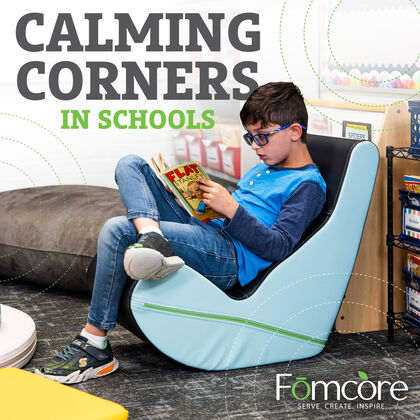Loading...

Calming Corners in Schools
As classrooms evolve to meet the social and emotional needs of students, tools like calming corners have become more prevalent in helping students manage stress and emotions throughout the school day. These spaces provide a dedicated area for students to take a moment, regulate their emotions, and return to class with a renewed sense of focus and calm. Calming corners are not just a response to emotional distress but a proactive strategy to foster mindfulness, self-awareness, and resilience in students.
How Calming Corners Work
Calming corners are designed to offer students a retreat where they can engage in self-regulation when they feel overwhelmed or distracted. These spaces encourage students to pause, reflect, and practice coping strategies such as deep breathing, mindfulness, or simply taking a break. By giving students a designated area for emotional resets, they learn valuable skills for managing their emotions constructively and independently. This approach helps reduce classroom disruptions and builds emotional resilience, which benefits students both inside and outside the classroom.
Unlike traditional disciplinary spaces, calming corners are not punitive. They are supportive tools that teach students that it’s okay to feel overwhelmed and that they have the resources to manage those feelings. The key is creating a positive association with the calming corner, ensuring students view it as a helpful resource rather than a place to escape their work or face consequences.
Designing a Calming Corner
The effectiveness of a calming corner is enhanced by thoughtful design. Typically, these spaces are located in quieter areas of the room and equipped with soft lighting, comfortable seating, and sensory tools. Soft seating plays a crucial role in creating a calming environment, allowing students to feel at ease while they regulate their emotions. For example, options like Fōmcore’s Nest Series provide a cozy, enclosed space that promotes mindfulness, giving students a moment of solitude when they need it. The ROK Drop, with its gentle rocking motion, is ideal for students who need to release energy in a healthy way, helping them stay calm while subtly moving. Meanwhile, the Hug Chair 2.0 offers a comforting, secure experience for students with sensory needs, providing pressure on both sides to help them feel grounded.
In addition to seating, sensory tools such as stress balls, fidget toys, calming jars, and guided breathing exercises can further enhance the calming corner. These elements engage students’ senses and help redirect their focus, promoting relaxation and emotional decompression. Visual aids like emotion charts or self-reflection worksheets are also effective in helping students identify and label their emotions, guiding them toward constructive coping strategies (Starr Commonwealth, The Social Emotional Teacher).
Emotional and Academic Benefits
Calming corners are more than just emotional outlets—they have tangible academic benefits as well. When students are able to manage their emotions effectively, they are more likely to remain focused on learning, participate in class, and perform better academically. Studies show that emotional regulation reduces disruptive behaviors and enhances students’ ability to engage in positive social interactions. By integrating calming corners into the classroom, educators foster a learning environment that values both emotional and academic growth.
By incorporating calming corners into the classroom, students are provided with the tools they need to manage their emotions and stay focused. Using thoughtful design elements such as soft seating, sensory tools, and visual aids, these spaces become powerful resources for students to practice emotional regulation in a supportive, non-judgmental environment. Calming corners are a vital tool in creating a balanced, emotionally intelligent classroom where students can thrive both personally and academically.
References
- Edutopia. "Incorporating the Calming Corner Into Station Rotation." Retrieved from www.edutopia.org.
- The Social Emotional Teacher. "Creating a Calm Down Corner: Fostering Emotional Regulation in the Classroom." Retrieved from www.thesocialemotionalteacher.com.
- Starr Commonwealth. "Calming Corner: Supporting Emotional Wellness." Retrieved from www.starr.org.